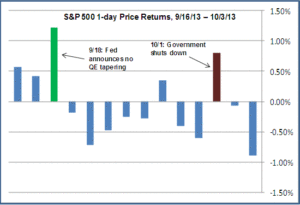
In the past three years, event risk has become a dominant paradigm in market performance. We have seen the Eurozone crisis, political dysfunction in Washington, and the occasional geopolitical flare-up send markets into a brief, sometimes deep contraction. These events have then been followed by the other dominant paradigm of this day and age, the relief rally. The underlying problems never really get fixed, but enough is done to prevent the worst case scenario from happening. Oiling the wheels of the relief rally are the constant ministrations of the Federal Reserve through its monetary stimulus measures. With this context in mind, let’s look at the latest “event” to force itself upon us: the US government shutdown; and the latest incarnation of the policy folly otherwise known as the debt ceiling.
Not Your Usual Event Risk Cycle
In our Market Flash last week we talked about the volatility gap, an indicator of a relatively calm attitude by investors towards the shutdown. When the event actually happened this week we did see a rise in the VIX index – the market’s so-called “fear gauge” – but a muted one. Consider the following chart:

Here is the key thing to focus on with this chart (apart from the wry fact that the market rallied on the day the shutdown began). With two key events in the mix – the Fed’s non-taper decision and the shutdown / debt ceiling crisis – as of yet there is not one single day in which the S&P 500 dropped by1% or more. In the world of event risk that is quite rare. The cycle certainly has been negative: as of the market close on 10/3 the index ended in negative territory for eight of the last ten days (as we write this piece on 10/4 equities are rallying, though). But the absence of extreme one-day drawdowns distinguishes this cycle from others, including Bernanke’s initial use of the word “tapering” in May, the post-election fretting over the fiscal cliff last November, and the succession of Eurozone flashpoints stretching back into 2011 and 2010.
What Happens Next?
We believe it is likelier than not that the political stalemate will be resolved at some point before Uncle Sam goes into default, i.e. sometime between now and the 17th of this month. The votes are there – the shutdown could end tomorrow and the debt ceiling could be raised with votes that currently exist in both the House and the Senate. Procedural logjams are preventing the facilitating bills to come to the floor. Those CNN soundbites floating out of the television are certainly vicious and personal, but we do not see the congressional leadership letting this get to the point where we actually go off the default cliff. House Speaker Boehner, through whom any bill has to pass in order to be voted on, has said as much.
Will There Be a Relief Rally?
The rather muted reaction to the latest events at play may keep a lid on the usual burst of enthusiasm that sends share prices soaring when it becomes clear that Armageddon once more is not happening. The S&P 500 has already gained around 20% for the year to date- sizable for a year in which economic growth remains modest and company earnings less robust than forecast at the outset. More likely than a giant relief rally, in our opinion, would be a moderate continuation of recent market-driving trends, such as cyclicals, non-US names and mid-small caps. The fourth quarter is often a momentum quarter, as money managers try to get their portfolios in line with the assets that are performing best ahead of year-end.
Nothing is certain, of course. There may be other X-factors that emerge in this present event cycle, or other events that pop into existence before the end of the year. As always, we have to stay vigilant and positioned for whatever possibilities present themselves.